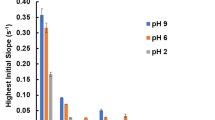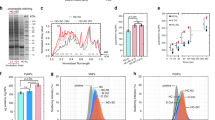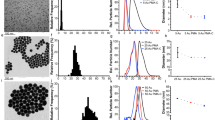Abstract
It is now known that nanoparticles, when exposed to biological fluid, become coated with proteins and other biomolecules to form a ‘protein corona’1. Recent systematic studies have identified various proteins that can make up this corona, but these nanoparticle–protein interactions are still poorly understood, and quantitative studies to characterize them are few in number. Here, we have quantitatively analysed the adsorption of human serum albumin onto small (10–20 nm in diameter) polymer-coated FePt and CdSe/ZnS nanoparticles by using fluorescence correlation spectroscopy. The protein corona forms a monolayer with a thickness of 3.3 nm. Proteins bind to the negatively charged nanoparticles with micromolar affinity, and time-resolved fluorescence quenching experiments show that they reside on the particle for ∼100 s. These new findings deepen our quantitative understanding of the protein corona, which is of utmost importance in the safe application of nanoscale objects in living organisms.
This is a preview of subscription content, access via your institution
Access options
Subscribe to this journal
Receive 12 print issues and online access
$259.00 per year
only $21.58 per issue
Buy this article
- Purchase on Springer Link
- Instant access to full article PDF
Prices may be subject to local taxes which are calculated during checkout




Similar content being viewed by others
References
Cedervall, T. et al. Understanding the nanoparticle–protein corona using methods to quantify exchange rates and affinities of proteins for nanoparticles. Proc. Natl Acad. Sci. USA 104, 2050–2055 (2007).
Scher, E. C., Manna, L. & Alivisatos, A. P. Shape control and applications of nanocrystals. Phil. Trans. R. Soc. Lond. A 361, 241–257 (2002).
Kudera, S. et al. Synthesis and perspectives of complex crystaline nano-structures. Phys. Stat. Sol. (a) 203, 1329–1336 (2006).
Jadzinsky, P. D., Calero, G., Ackerson, C. J., Bushnell, D. A. & Kornberg, R. D. Structure of a thiol monolayer-protected gold nanoparticle at 1.1 Å resolution. Science 318, 430–433 (2007).
Colvin, V. L. The potential environmental impact of engineered nanomaterials. Nature Biotechnol. 21, 1166–1170 (2003).
Sun, S., Murray, C. B., Weller, D., Folks, L. & Moser, A. Monodisperse FePt nanoparticles and ferromagnetic FePt nanocrystal superlattices. Science 287, 1989–1992 (2000).
Dabbousi, B. O. et al. (CdSe)ZnS core−shell quantum dots: synthesis and characterization of a size series of highly luminescent nanocrystallites. J. Phys. Chem. B 101, 9463–9475 (1997).
Pellegrino, T. et al. Hydrophobic nanocrystals coated with an amphiphilic polymer shell: a general route to water soluble nanocrystals. Nano Lett. 4, 703–707 (2004).
Lin, C. A. et al. Design of an amphiphilic polymer for nanoparticle coating and functionalization. Small 4, 334–341 (2008).
Fernandez-Arguelles, M. T. et al. Synthesis and characterization of polymer-coated quantum dots with integrated acceptor dyes as FRET-based nanoprobes. Nano Lett. 7, 2613–2617 (2007).
Wu, X. et al. Immunofluorescent labeling of cancer marker Her2 and other cellular targets with semiconductor quantum dots. Nature Biotechnol. 21, 41–46 (2003).
He, X. M. & Carter, D. C. Atomic structure and chemistry of human serum albumin. Nature 358, 209–215 (1992).
Lamb, D. C., Schenk, A., Röcker, C., Scalfi-Happ, C. & Nienhaus, G. U. Sensitivity enhancement in fluorescence correlation spectroscopy of multiple species using time-gated detection. Biophys. J. 79, 1129–1138 (2000).
Maiti, S., Haupts, U. & Webb, W. W. Fluorescence correlation spectroscopy: diagnostics for sparse molecules. Proc. Natl Acad. Sci. USA 94, 11753–11757 (1997).
Rigler, R. & Elson, E. S. (eds) Fluorescence Correlation Spectroscopy: Theory and Applications (Springer, 2001).
Thompson, N. L. in Topics in Fluorescence Spectroscopy Vol. 1 (ed. Lakowicz, J. R.) 337–378 (Plenum Press, 1991).
Ferrer, M. L., Duchowicz, R., Carrasco, B., de la Torre, J. G. & Acuna, A. U. The conformation of serum albumin in solution: a combined phosphorescence depolarization-hydrodynamic modeling study. Biophys. J. 80, 2422–2430 (2001).
Kohlrausch, R. Theorie des elektrischen Rueckstandes der Leidner Flasche. Pogg. Ann. Phys. Chem. 91, 56–82 (1854).
Cedervall, T. et al. Detailed identification of plasma proteins adsorbed on copolymer nanoparticles. Angew Chem. Int. Ed. 46, 5754–5756 (2007).
Schenk, A., Ivanchenko, S., Röcker, C., Wiedenmann, J. & Nienhaus, G. U. Photodynamics of red fluorescent proteins studied by fluorescence correlation spectroscopy. Biophys. J. 86, 384–394 (2004).
Wiedenmann, J. et al. EosFP, a fluorescent marker protein with UV-inducible green-to-red fluorescence conversion. Proc. Natl Acad. Sci. USA 101, 15905–15910 (2004).
Dertinger, T. et al. Two-focus fluorescence correlation spectroscopy: a new tool for accurate and absolute diffusion measurements. ChemPhysChem 8, 433–443 (2007).
Acknowledgements
This work was supported by the Deutsche Forschungsgemeinschaft (DFG) through the Center for Functional Nanostructures (CFN) and Schwerpunktprogramm (SPP) 1313, grants NI291/7 and PA794/4.
Author information
Authors and Affiliations
Contributions
C.R. and G.U.N. conceived and designed the experiments. C.R. and M.P. performed the experiments. C.R. and M.P. analysed the data. F.Z. and W.P. contributed materials. C.R., W.P. and G.U.N. co-wrote the paper. All authors discussed the results and commented on the manuscript.
Corresponding author
Supplementary information
Supplementary information
Supplementary information (PDF 567 kb)
Rights and permissions
About this article
Cite this article
Röcker, C., Pötzl, M., Zhang, F. et al. A quantitative fluorescence study of protein monolayer formation on colloidal nanoparticles. Nature Nanotech 4, 577–580 (2009). https://doi.org/10.1038/nnano.2009.195
Received:
Accepted:
Published:
Issue Date:
DOI: https://doi.org/10.1038/nnano.2009.195
This article is cited by
-
Current analytical approaches for characterizing nanoparticle sizes in pharmaceutical research
Journal of Nanoparticle Research (2024)
-
Protein corona and exosomes: new challenges and prospects
Cell Communication and Signaling (2023)
-
Fluorescent Lateral Flow Assay with Carbon Nanodot Conjugates for Carcinoembryonic Antigen
BioChip Journal (2023)
-
Mesoscopic simulations of protein corona formation on zwitterionic peptide-grafted gold nanoparticles
Journal of Nanoparticle Research (2023)
-
Study of enhanced photodegradation of methylene blue in presence of grown SnSe nanoparticles
Journal of Materials Science: Materials in Electronics (2023)



